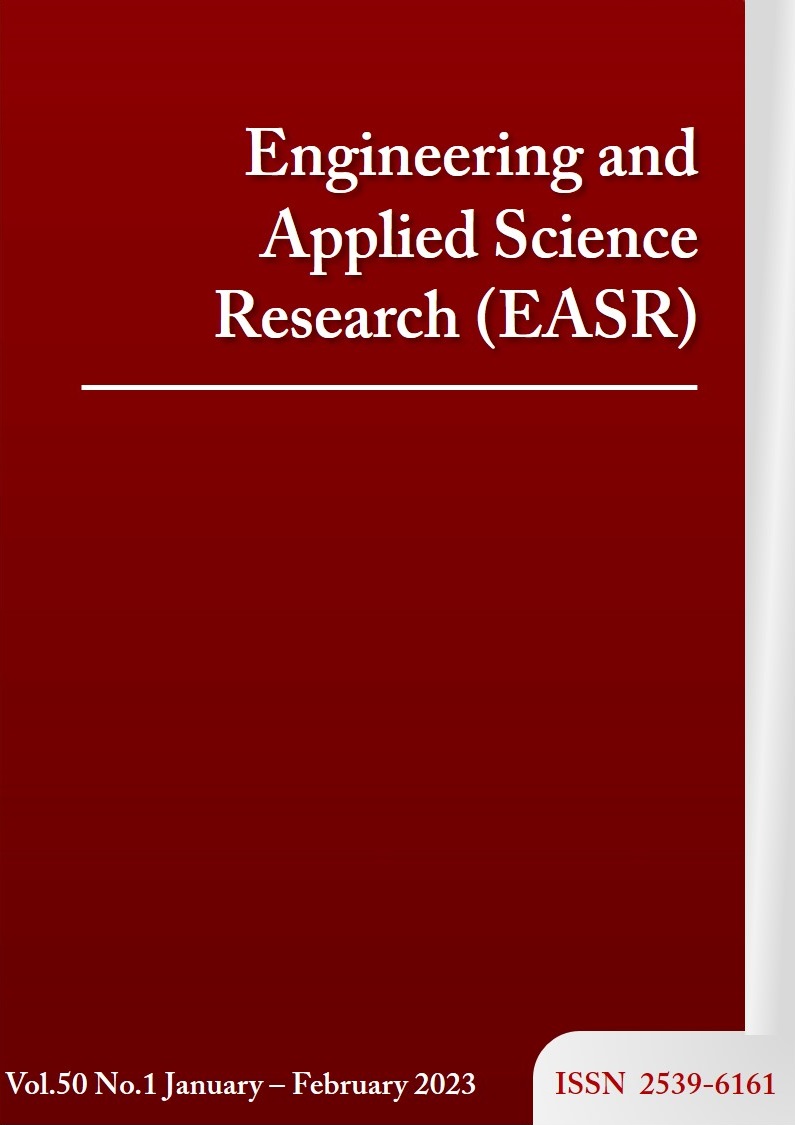Application of Python and OpenCV on industrial cycle time study
Main Article Content
Abstract
Motion and time study enhance business performance by improving productivity. The cycle times are collected repetitively to confirm their accuracy and precision. The time taken to complete tasks by engineers or technicians varies due to work experience and educational background, which can cause a large number of repetitions in the time observation. Recent technologies to help shorten time and motion studies as process improvement include digital stopwatches and mobile applications. However, these only reduce documentation time, not observation time. Therefore, this project integrated machine vision technology to reduce observation time in a motion and time study project. The proposed algorithm was developed using OpenCV with Python. Cycle time, measured by the proposed algorithm using work process videos, was then compared with cycle time observed by human appraisers. Results confirmed that the cycle time detected by the proposed algorithm differed from the cycle time evaluated by appraisers with lower variation, i.e., requiring less replicates of observations. Outcomes of this research can be used to shorten the time study process and facilitate remote monitoring in process improvement projects.
Article Details

This work is licensed under a Creative Commons Attribution-NonCommercial-NoDerivatives 4.0 International License.
This work is licensed under a Creative Commons Attribution-NonCommercial-NoDerivatives 4.0 International License.
References
Meyers FE. Motion, and time study: improving work methods and management. Upper Saddle River: Prentice Hall; 1992.
Feld WM. Lean manufacturing: tools, techniques, and how to use them. Florida: CRC Press; 2000.
Mcframe-Asia.Com. mcframe MOTION software [Internet]. 2022 [cited 2022 Oct 11]. Available from: https://www.mcframe-asia.com/mcframe-motion/.
Gaorfid.Com. People tracking system for manufacturing facilities [Internet]. 2022 [cited 2022 Oct 11]. Available from: https://gaorfid.com/people-tracking-for-manufacturing-facilities/.
Bradski G. The OpenCV library. Dr. Dobb's Journal: Software Tools for the Professional Programmer. 2000;25(11):120-3.
Bradski G, Kaehler A. Learning OpenCV: computer vision with the OpenCV library. California: O'Reilly Media; 2008.
Brahmbhatt S. Practical OpenCV. California: Apress Berkeley; 2013.
Howse J. OpenCV computer vision with python. Birmingham: Packt Publishing; 2013.
Burden J, Cleland M, Conway M, Falconer M, Green R, Geoff Chase JJ, et al. Tracking a single cyclist during a team changeover on a velodrome track with Python and OpenCV. Procedia Eng. 2010;2(2):2931-5.
Parveen S, Shah J. A motion detection system in python and OpenCV. Proceedings of the 3rd International Conference on Intelligent Communication Technologies and Virtual Mobile Networks; 2021 Feb 4-6; Tirunelveli, India. India: IEEE; 2021. p. 1378-82.
Yedulapuram S, Arabelli R, Mahender K, Sidhardha C. Automatic door lock system by face recognition. IOP Conf Ser: Mater Sci Eng. 2020;981:032036.
Azhari Halim MA, Othman MFI, Abidin AZZ, Hamid E, Harum N, Shah WM. Face recognition-based door locking system with two-factor authentication using OpenCV. Proceedings of the 6th International Conference on Informatics and Computing; 2021 Nov 3-4; Jakarta, Indonesia. Indonesia: IEEE; 2021. p. 1-7.
Ahamad AH, Zaini N, Latip MFA. Person detection for social distancing and safety violation alert based on segmented ROI. Proceedings of the 10th IEEE International Conference on Control System, Computing, and Engineering; 2020 Aug 21-22; Penang, Malaysia. Malaysia: IEEE; 2020. p. 113-8.
Verma S, Jain PK. COVID-19: Automatic social distancing rule violation detection using PP-Yolo & Tensorflow in OpenCV. Proceedings of the 2022 International Conference for Advancement in Technology; 2022 Jan 21-23; Goa, India. India: IEEE; 2022. p. 1-6.
Terreran M, Lamon E, Michieletto S, Pagello E. Low-cost scalable people tracking system for human-robot collaboration in an industrial environment. Procedia Manuf. 2020;51:116-24.
Geiselhart F, Otto M, Rukzio E. On the use of multi-depth-camera-based motion tracking systems in production planning environments. Procedia CIRP. 2016;41:759-64.
Montgomery DC. Introduction to statistical quality control. 8th ed. New Jersey: John Wiley & Sons; 2020.
Durivage, MA. Practical attribute and variable measurement systems analysis (MSA): a guide for conducting Gage R&R studies and test method validations. Wisconsin: ASQ Quality Press; 2015.
Kappele WD, Raffaldi JD. An introduction to gage R&R: Gage R&R studies can help operators from making costly measurement errors. Quality magazine [Internet]. 2005 [cited 2022 Oct 11]. Available from: https://www.qualitymag.com/articles/83529-quality-101-an-introduction-to-gage-r-r?.
Minitab.Com. Minitab: Data analysis, statistical & process improvement tools [Internet]. 2022 [cited 2022 Oct 11]. Available from: https://www.minitab.com.
Automotive Industry Action Group (AIAG). Measurement Systems Analysis (MSA). 4th ed. Miami: AIAG; 2010.



